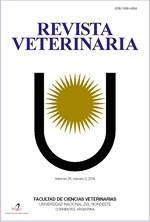Relationship between parasitic load and Th1 lymphocytes in skin’s biopsies of dogs with leishmaniasis
DOI:
https://doi.org/10.30972/vet.3114610Keywords:
Dogs, leishmaniasis, lymphocytes Th1, immunohistochemistry, skin biopsy, parasitic amountAbstract
Visceral leishmaniasis (VL) is a severe chronic systemic disease caused by Leishmania donovani or L. infantum. Several studies have shown that susceptibility to VL is related to high levels of circulating antibodies and a depression of the immunity mediated by Th1 cells, mainly with decreased production of interferon (IFN-γ) and interleukin-12 (IL-12). Like human leishmaniasis, active canine VL is characterized by polyclonal activation of B-cells and specific immune suppression. Canine patients with reactive serological diagnosis to Leishmania sp were selected and samples were taken for direct parasitological examination and skin biopsies of the pinna for the immune-histochemistry technique, in order to detect Th1 lymphocytes in relation to parasitic amount. In samples of animals without symptoms and high parasite load, the number of Th1 lymphocytes did not exceed 4 cells per field, while in the samples with moderate and low parasite loads, the number of Th1 lymphocytes exceeded 8 cells per field of higher magnification, reaching up to 10. In animals with symptoms, it was observed that in samples with moderate and high parasite loads, the number of Th1 lymphocytes did not exceed 5 cells, while the samples with low parasitic amount exceeded 8 cells per field of higher magnification. It is concluded that the presence or absence of symptoms in canines with VL does not depend on the parasitic amount found in skin biopsies. On the other hand, it was observed that the high parasitic amount is related to immune suppression mediated by Th1 lymphocytes, while in animals with high immunological response, the number of parasites is low.
Downloads
References
Abbas AK, Murphy KM, Sher A. 1996. Functional diversity of helper T lymphocytes. Nature 383: 787-793.
Akuffo H, Maasho K, Britton S. 1996. Immunity to human leishmaniasis. Parasitology of the 21st Century, CAB
International 23-33.
Alexander J, Bryson K. 2005. T helper (h)1/Th2 and Leishmania: paradox rather than paradigm. Immunol Lett 99: 17-23.
Antoine JC, Prina E, Courret N, Lang T. 2004. Leishmania spp.: on the interactions they establish with antigenpresenting cells of their mammalian hosts. Adv Parasitol 58: 1-68.
Bhattacharya P, Ali N. 2013. Involvement and interactions of different immune cells and their cytokines in human visceral leishmaniasis. Rev Soc Bras Med Trop 46: 128-134.
Banchereau J et al. 2000. Immunobiology of dendritic cells. Ann Rev Immunol 18: 767-811.
Bogdan C, Rollinghoff M, Diefenbach A. 2000. The role of nitric oxide in innate immunity. Immunol Rev 173: 17-26.
Brandonisio O et al. 2002. Macrophage chemotactic protein-l macrophage inflammatory protein-l alpha induce nitric oxide release and enhance parasite killing in Leishmania infantum infected human macrophages. Clin Exp Med 2: 125-129.
Carvalho EM, Bacellar O, Barral A, Badaro R, Johnson WD. 1989. Antigen-specific immuno suppression in visceral leishmaniasis is cell mediated. J Clin Invest 83: 860-864.
Costa DL et al. 2013. Serum cytokines associated with severity
and complications of kala-azar. Pathog Glob Health 107: 78-87.
Dujardin JC et al. 2008. Spread of vector-borne diseases and neglect of leishmaniasis, Europe Emerg Infect Dis 14:1013-1018.
Lima GM et al. 1998. The role of polymorphonuclear leukocytes in the resistance to cutaneous leishmaniasis. Immunol Lett 64: 145-151.
Lockesley RM, Louis JA. 1992. Immunology of leishmaniasis. Curr Opin Immunol 4: 413-418.
Manna PP, Chakrabarti G, Bandyopadhyay S. 2010. Innate immune defense in visceral leishmaniasis: cytokine mediated protective role by allogeneic effector cell. Vaccine 28: 803-810.
Murray HW. 1997. Endogenous interleukin-12 regulates acquired resistance in experimental visceral leishmaniasis. J Infect Dis 175: 1477-1479.
Murray HW, Berman JD, Davies CR, Saravia NG. 2005. Advances in leishmaniasis. Lancet 366: 1561-1577.
Nylen S, Sacks D. 2007. Interleukin-10 and the pathogenesis of human visceral leishmaniasis. Trends Immunol 28: 378-384.
Peruhype MV et al. 2005. Immune response in human visceral leishmaniasis: analysis of the correlation between innate immunity cytokine profile and disease outcome. Scand J Immunol 62: 487-495.
Reis AB et al. 2006. Parasite density and impaired biochemical / hematological status are associated with severe clinical aspects of canine visceral leishmaniasis. Res Vet Sci 81: 68-75.
Reis AB et al. 2009. Systemic and compartmentalized immune response in canine visceral leishmaniasis. Vet Immunol Immunopathol 128: 87-95.
Santos GM et al. 2002. Cytokine expression during the outcome of canine experimental infection by Leishmania infantum. Vet Immunol Immunopathol 88: 21-30.
Vangisbergen KP, Geijtenbeek TB, Vankooyk Y. 2005. Close encounters of neutrophils and DCs. Trends Immunol 26: 626-631.
Vangriensven J, Diro E. 2012 Visceral leishmaniasis. 2012. Infect Dis Clin North Am 26: 309-322.
Vonstebut E, Udey MC. 2004. Requirements for Th1-dependent immunity against infection with Leishmania major. Microbes Infect 6: 1102-1109.
Downloads
Published
How to Cite
Issue
Section
License
Revista Veterinaria (Rev. Vet.) maintains a commitment to the policies of Open Access to scientific information, as it considers that both scientific publications as well as research investigations funded by public resources should circulate freely without restrictions. Revista Veterinaria (Rev. Vet.) ratifies the Open Access model in which scientific publications are made freely available at no cost online.








